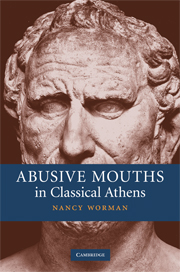Book contents
- Frontmatter
- Contents
- Acknowledgments
- List of abbreviations
- Introduction
- 1 The mouth and its abuses in epic, lyric, and tragedy
- 2 Open mouths and abusive talk in Aristophanes
- 3 Gluttonous speechifying in Euripides' Cyclops
- 4 Crude talk and fancy fare in Plato
- 5 Defamation and oral excesses in Aeschines and Demosthenes
- 6 The intemperate mouth in Aristotle and Theophrastus
- Epilogue
- Bibliography
- Index locorum
- General index
1 - The mouth and its abuses in epic, lyric, and tragedy
Published online by Cambridge University Press: 08 March 2010
- Frontmatter
- Contents
- Acknowledgments
- List of abbreviations
- Introduction
- 1 The mouth and its abuses in epic, lyric, and tragedy
- 2 Open mouths and abusive talk in Aristophanes
- 3 Gluttonous speechifying in Euripides' Cyclops
- 4 Crude talk and fancy fare in Plato
- 5 Defamation and oral excesses in Aeschines and Demosthenes
- 6 The intemperate mouth in Aristotle and Theophrastus
- Epilogue
- Bibliography
- Index locorum
- General index
Summary
κἀν Σαλμυδ[ησσ]⼱ἱ γυμνὸν εὐΦρονε[
Θρήικες ἀκρό[κ]ομοι
λάβοιεν. ἔνθα πόλλ᾿ ἀναπλἀὨσαι κακὰ
δούλιον ἄρτον ἔδων,
ῥίγει πεπηγότ᾿ αὐτόν ἐκ δὲ τοῦ χνόου
Φυκία πόλλ᾿ ἐπέχοι,
κροτέοι δ᾿ ὀδόντας. ὡς [κ]ύων ἐπὶ στόμα
κείμενος ἀκρασίηἱ
And in Salmydessus may the top-knotted Thracians
graciously take him in, naked,
where he will carry out many lowly tasks
eating slave's bread,
seized by cold; and from the foam
may he clutch heaps of seaweed,
chattering his teeth, mouth down like a dog
lying in helplessness.
A dog's life, snappish talk, the ravenous mouth: these rude images cluster in the language of insult from early on in Greek poetry, often crystallizing in the form of curses such as this one. While the features of iambic literature clearly developed piecemeal, disparate settings for poetic performance offer strikingly similar figurative language to capture the speaking styles and characterizations of both those who deploy insults and their targets. In the broadest sense, this abusive talk runs the gamut from invective and character assassination on the one hand, to mockery and lampoon on the other; that is to say, some modes are quite vitriolic, others more droll. The genres in which such abuse appears reflect this diversity. Indeed, I would submit that abusive modes shadow many, if not most, genres, often functioning in irreverent, devious, or sinister contrast to the perspectives openly valued by the given text.
- Type
- Chapter
- Information
- Abusive Mouths in Classical Athens , pp. 25 - 61Publisher: Cambridge University PressPrint publication year: 2008



